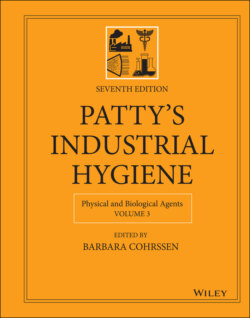Читать книгу Patty's Industrial Hygiene, Physical and Biological Agents - Группа авторов - Страница 145
6.7 Glassblowing and Foundries
ОглавлениеGlassblowers and foundry workers can be exposed to excessive near‐IR irradiances to the eyes when working at open furnaces . Significant UV radiation may also be emitted from some types of glass in the molten state (91). Shielding, in the form of protective eyewear and possibly other barriers, is the most common means of controlling exposure. Exposure can also be reduced by increasing the distance from the hot source through the use of long handles on implements such as ladles, rods, or tongs (93).
Glassblowers often wear didymium glass lenses to filter out intense yellow light at about 590 nm emitted by sodium in molten glass. Didymium glass has high transmittance in much of the IR region, however, and should, therefore, be combined with additional IR and UV filtering (91). Cobalt blue lenses are effective at filtering yellow light, UV, and IR. Filter lenses with shade number no less than 2.5 are recommended for work with soda lime or quartz glass (91), and higher shades may be appropriate (90).
A guideline published by the American Foundry Society recommends shade numbers for eye protection during melting and pouring operations based on the metal being handled: iron (shade Nos. 3–5: green); steel (shade No. 8: green, or shade No. 6: cobalt blue); brass/bronze (shade Nos. 3–5: green, or shade No. 3: green with No. 3 aluminized face shield, or shade No. 6 cobalt blue half lenses); aluminum (clear, no‐tint) or magnesium (clear, no‐tint) (94).
